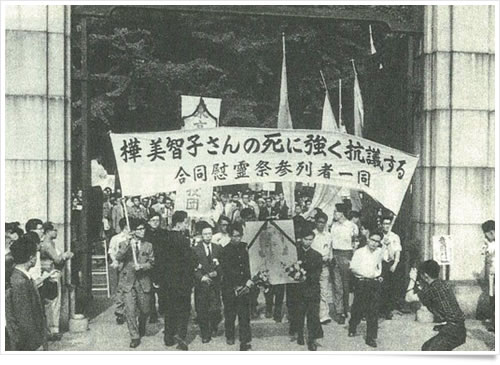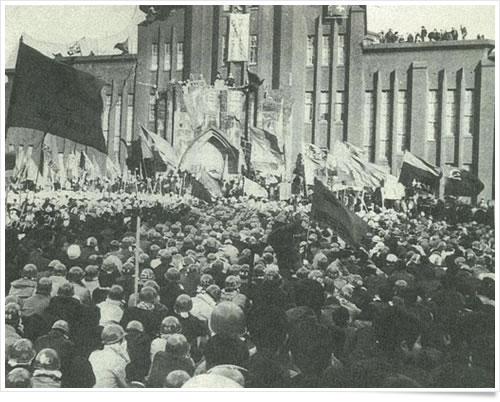-
Even though the gates to Todai were said to have opened, the campus life was not easy for the female students at that time. For example, "When they opened a door to a lecture hall, all I could see was a sea of black. I was taken aback when all the high-collared male students turned around at once." But these weren't a bunch of weak women.
1) Female Students' Dormitory in Shirokane
In the year 1951 when Tadao Yanaihara was the dean of the College of Arts and Sciences, a very thick letter of 9 pages arrived. Hiroko Kageyama (1954 graduated in economics) and Tomiko Kato (1954 graduated in law) had spoken it over and sent a direct appeal for the construction of a dedicated female students' dormitory and to highlight the hardships that less well-off female students faced in coming to Tokyo from the countryside and trying to continue their studies all alone. Dean Tadao Yanaihara and President Shigeru Nambara found their letter moving and two years later in September, 1953, "Shirokane Ryo" in Shirokane-Sanko-cho, Minato Ward opened its doors. The first year the dormitory had 14 residents. Thereafter, as the number of female students increased, a new dormitory was completed in 1966 that housed 92 residents.
2) Campus Disturbances—Security and the Death of Michiko Kamba
In 1959, on the day of a joint effort by the Committee to Prevent the Revision of "The Treaty of Mutual Cooperation and Security", all the students of Todai held a mass rally in Hongo campus (1,400 protesters). From this time on, the strife spread across the school and even female students got involved. Then, the next year on June 15, 1960, some 10,000 students surrounding the House of Representatives broke through the barricades and rushed into the Diet. The police counterattacked and a fierce struggle ensued; as the fighting and bloodshed spread, Michiko Kamba (at the time a third-grade female student of Japanese history, Faculty of Letters) died.

(Picture 2)
The second strife at Todai occurred in 1968 at a meeting of Faculty of Medicine with demands for a resolution to the problems of the intern system and started with the holding of an open-ended strike. When the department tried to deal with it, it was like an explosion of embers that sparked all over campus…in Faculties of Letters and Economics. In June, President Kazuo Okochi tried to hold a "President's Press Conference", but it ended in failure from the heckling and roar of some 6,000 students. Subsequently, Faculties of Engineering, Law, Education and Sociology started striking and the students occupied the Yasuda Auditorium. In November, President Okochi assumed responsibility for the problems and resigned. However, opposition soon arose among students in the different sects of student groups such as "Zenkyoto", resulting in things like non-political students organizing a class alliance in Komaba, the beginning of a movement called "the Public Order Wing" and finally, the gathering of 7 departments in the Chichibunomiya Rugby Stadium in January, 1969. It was a massive gathering with some 7,500 students and 1,500 faculty participating. The university and groups representing the students created and exchanged documents confirming agreements to render control to the university. Shortly after that, on January 18 and 19, requests for the dispatch of police were made on the pretext of dealing with forced exclusions from the Hongo campus and the illegal occupation of buildings by parties unrelated to the university. On this day, the country sat glued to their televisions watching the so-called "Battle for Yasuda Auditorium" unfold.
Inside of Yasuda Auditorium some Todai female students called "Gewalt Rosa" stood holding metal pipes and screaming in their high-pitched voice.
Inside of Yasuda Auditorium some Todai female students called "Gewalt Rosa" stood holding metal pipes and screaming in their high-pitched voice.

(Picture 3)
3) Activities of Todai Women Alumnae
In 1961, volunteer Todai alumnae organized "Satsuki-kai", which took place during the beautiful azalea blossom season. With the trends around the world against Todai women, they wanted to encourage each other and exchange information in the hope of developing together. Since that time they have been active in their pursuits for nearly 50 years. Many of the women who graduated from Todai are still active.
The following three alumnae became the Minister of Education (Minister of Education, Culture, Sports, Science and Technology).
Mayumi Moriyama (1950 graduated in Law)
Ryoko Akamatsu (1953 graduated in Law)
Atsuko Toyama (1962 graduated in Law)
In addition to them, many alumnae have been active in various fields, such as former Minster of Foreign Affairs Yoriko Kawaguchi (1965 graduated in Arts and Sciences), and Fusae Ota, former Osaka Governor (1975 graduated in Economics). The first alumnae found it difficult to find work, so many of them took the Government Official Examination. In 1985, "Equal Employment Opportunity Law for Men and Women" was enacted, thanks to the efforts of a number of Todai women bureaucrats, not least of whom were successive directors of the Women's and Minors' Bureau in the Ministry of Labor, Mayumi Moriyama, Ryoko Akamatsu and Hisako Takahashi (1953 graduated in Economics). It crystallized the ideas of the long-suffering Todai female students "Workplace refugees."
There are alumnae in other fields as well. The singer Tokiko Kato (1968 graduated in Letters) as well as some recent young alumnae who are active as Television Stars.
The following three alumnae became the Minister of Education (Minister of Education, Culture, Sports, Science and Technology).
Mayumi Moriyama (1950 graduated in Law)
Ryoko Akamatsu (1953 graduated in Law)
Atsuko Toyama (1962 graduated in Law)
In addition to them, many alumnae have been active in various fields, such as former Minster of Foreign Affairs Yoriko Kawaguchi (1965 graduated in Arts and Sciences), and Fusae Ota, former Osaka Governor (1975 graduated in Economics). The first alumnae found it difficult to find work, so many of them took the Government Official Examination. In 1985, "Equal Employment Opportunity Law for Men and Women" was enacted, thanks to the efforts of a number of Todai women bureaucrats, not least of whom were successive directors of the Women's and Minors' Bureau in the Ministry of Labor, Mayumi Moriyama, Ryoko Akamatsu and Hisako Takahashi (1953 graduated in Economics). It crystallized the ideas of the long-suffering Todai female students "Workplace refugees."
There are alumnae in other fields as well. The singer Tokiko Kato (1968 graduated in Letters) as well as some recent young alumnae who are active as Television Stars.





